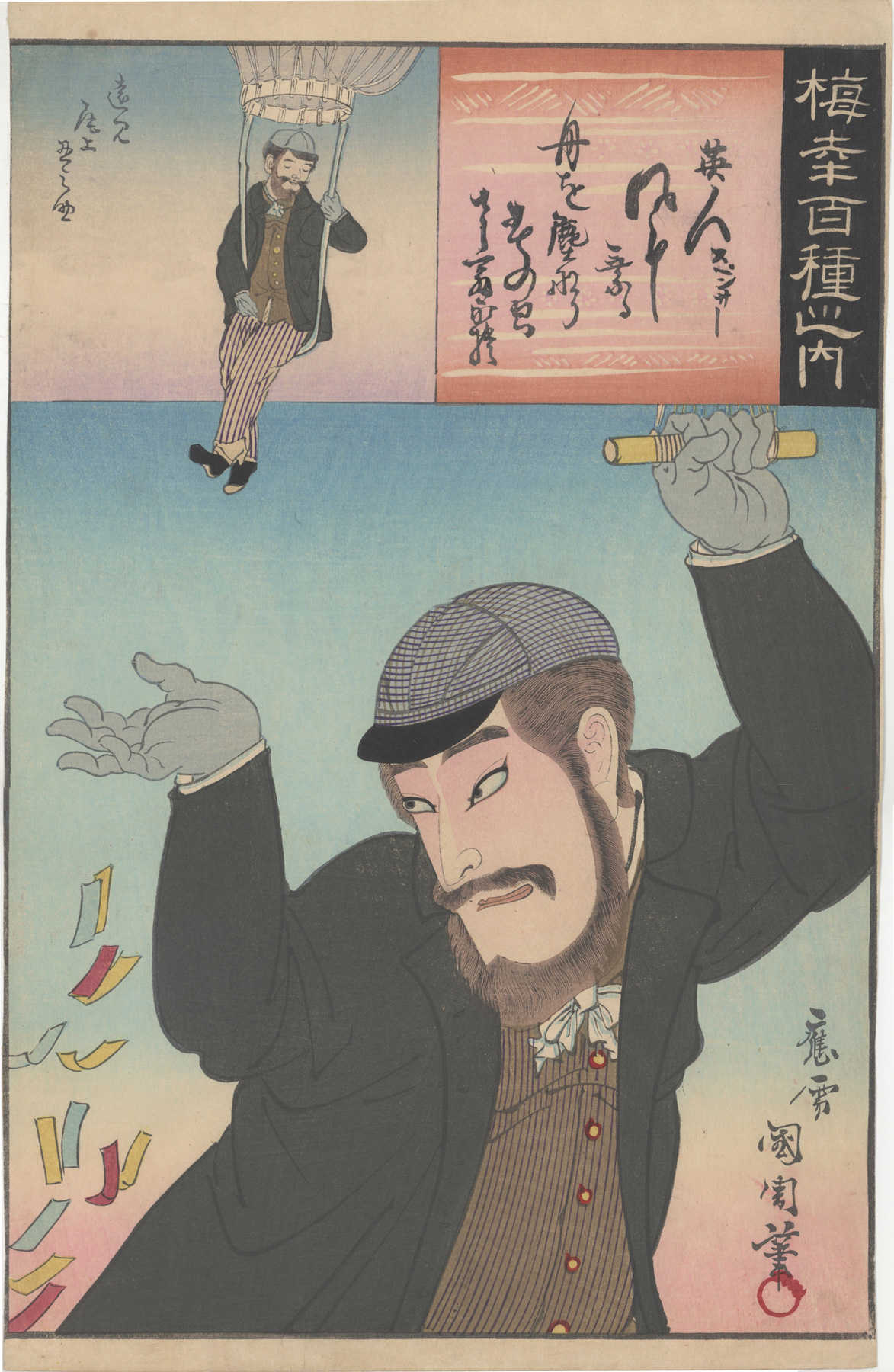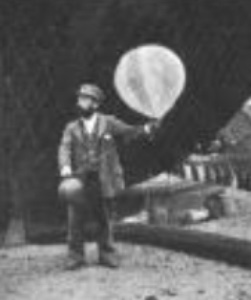About This Print
The Series "One Hundred Roles of Baikō"
Source: Time Present and Time Past: Images of a Forgotten Master: Toyohara Kunichika (1835-1900), Amy Reigle Newland, Hotei Publishing, 1999, p. 26, 27.
In 1893 Kunichika undertook a commission for two series of single-sheet portraits, each dedicated to the two most famous actors of their time, Ichikawa Danjūrō IX (1838-1903) and Onoe Kikugorō V (1844-1903). The first of these, One hundred roles of Danjūrō, featured the major roles of Ichikawa Danjūrō IX in a set of half-length portraits. (See print IHL Cat. #s 663, 689 and 701.) The second, One hundred roles of Baikō, featured the major roles of Onoe Kikugorō V and included an insert on the top of the print depicting a supporting actor. Both the series were commissioned by Fukuda Kumajirō and Gusokuya Kahei. These two series are regarded as ‘monuments to his [Kunichika’s] career’.
The name "Baikō" in the series title was the haiku pen name of Onoe Kikugorō V and Kunichika was on friendly terms with him, often drinking tea and chatting backstage.
Percival Spenser's Balloon Ascent - Stories from The Japan Weekly Mail
Story of October 11, 1890: "The Parachutist in Japan" As will be seen from our advertising columns Mr. Percival Spencer, whose daring parachute tests have been noticed frequently of late in China and other eastern papers, intends to drop from his balloon at the Public Gardens on Sunday next. If fine weather be experienced, Mr. Spencer should have a big crowd of spectators.
Story of November 28, 1890: "The Balloon Ascent From Uyeno Park"
On Monday afternoon at half-past two o’clock Mr. Spencer made hissecond balloon ascent in Tokyo. Hisfirst performance was given by special desire of the Emperor, and took place inthe open space before the main entrance to the Palace. The performance yesterday was of a publiccharacter, and the interest excited among the citizens of Tokyo was very great. The Authorities permitted Mr. Spencer to makeuse of the area immediately in front of the Permanent Museum in Uyeno Park, andas the building employed for the purposes of the Industrial Exhibition arestill standing, this central court is completely enclosed, thus forming anideal place for Mr. Spencer’s object. The court was divided into three rings, the innermost of whichconstituted the first class, the middle the second class, and the outermost thethird class, the prices of admission being one yen, fifty sen, and twenty senrespectively. Every one of the rings wascompletely filled, the total number of paying spectators aggregating from fourto five thousand. Needless to say thatthe crowds outside were far greater. Thewhole of Ueyno Park was packed to overflowing, and from one o’clock onwards nolittle difficulty was experienced in forcing a passage through the mob to thegate of the inner court. The proverbialgood humour and order-preserving disposition of Japanese assemblies displayeditself as usual, however, so that women and children were as safe among thephalanx of people as they would have been in the open streets. Strange to say, very few foreigners werepresent, a fact to be accounted for only the supposition that the foreignresidents of Tokyo had already witnessed Mr. Spencer’s performances inYokohama, or that the failure to advertise in the English local press had leftpeople in ignorance of the programme. With respect to the foreign portion of the audience, there is a pointwhich Mr. Spencer, other who, like him, live by public favour, will do well tonote, namely, that the same measure of courtesy meted out to Occidentals onthese occasions, must be meted out to Orientals also. It was observed yesterday that every foreignlady or gentleman found admittance without question inside the central ring tothe immediate vicinity of the balloon and apparatus, whereas with very few exceptionseveryone wearing Japanese costume was excluded. Such discrimination can only have the effect of rendering unpopular allexhibitions by foreign performers. Amongthose present inside the central circle were H.I.H. Prince Yamashina, and theirExcellencies Count Kawamura and Viscounts Aoki and Yenomoso. At ten minutes past two o’clock the firstpilot balloon was sent up. A grotesquefigure of a man without any command of legs or arms, it ascended with limpgravity and occasional disturbances of equilibrium that afforded much amusementto the spectators. The day was beautifulbright and still, perfect Japanese autumnal weather, but the transparent dummyevidently felt a breeze not perceptible by more substantial beings, for itfloated off in the direction of Hongo until a reverse current, catching it inan upper stratum of atmosphere, wafted it back so that it finally descended onthe margin of the Shinobazu Lake. Another pilot, dispatched upwards some minutes afterwards, voyaged offsteadily towards Sarugadai, the result of the two experiments being that peopleremained in a state of pleasing uncertainty as to the direction which theaeronaut himself would take. The bigballoon was by this time fully inflated, but so still was the atmosphere thatnot a motion of the silken globe could be detected: it remained strainingsteadily on its detaining ropes as motionless as though crystallized in itsplace. The hour fixed for the ascent hadnow passed, and the crowd, on the tip-toe of excitement, greeted Mr. Spencerwith a low hum as he stepped forward and began to untie the cords by which thelower end of the balloon had been wrapped around the gas-conducting pipe. Mr. Spencer is of low stature, bandy-legged,light-haired, and resolute looking, but it may be gathered from his mien that heis not without consciousness of the perils attending his exploit. Under any circumstances a parachute descentmust be a dangerous business, but where a great number of lofty trees aredotted about the ground, as is the case in Uyeno Park, the chances of accidentcannot but be increased considerably. Rumour says, indeed, that the risk run by the aeronaut has attached tohim a correspondent of an American journal, who firmly believes that his thirstfor sensational copy will be satisfied one of these days at Mr. Spencer’scost. The preparations made by theintrepid performer were few and simple. They consisted chiefly in divesting himself of a gold medal and hiswatch and chain, exchanging his hat for a tight-fitting tweed cap, filling hispockets with advertisements to be scattered from the clouds, and seizing firmhold of the jacket by which he is attached to the parachute in thedescent. Wonder-exciting pictures of thefeat, posted in public places, represent the aeronaut suspended from hisparachute by one hand and swaying nonchalantly earthwards. But that is a balloonist’s license. It is plain that no fingers, howevermuscular, could be trusted to sustain a man at the moment of more or less rudeshock when the swift downward motion of his leap from the balloon is arrestedby the expansion of the parachute. J The thing is managed by the aid of ajacket or sling passing round the body under the arms. This Mr. Spencer fixes when he has reachedsuch a height that his actions are only discernible by the aid of a glass. The parachute is tied to the side of theballoon by a cord which, being just capable of supporting a weight of sixtylbs., gives way and allows the parachute to become detached when Mr. Spencerconsigns himself to it. The descent ofthe abandoned balloon is ingeniously managed by means of a small weightattached to the side. So long as theaeronaut is seated on the trapeze this comparatively trifling weight does notdisturb the equilibrium of the balloon, but when the man leaps out, the littleweight causes the silk globe to tilt over, until, the unclosed end cominguppermost, the gas escapes and the balloon, reduced to the semblance of a longstreamer, floats slowly downwards. Contrary to the indications furnished by the pilot voyagers, the balloonyesterday rose at first quite vertically with admirable grace and steadiness,and it seemed for a moment as though Mr. Spencer’s hope of descending withinthe enclosure from which he had ascended would be satisfied. But at a considerable elevation aneastward-setting current of air was entered, and when Mr. Spencer consignedhimself to the parachute, he was sailing in the direction of Asakusa, in thevicinity of which he ultimately alighted safely. The ascent lasted, as far as could be judged,about a hundred seconds, and the descent was accomplished in nearly the sameinterval, some four seconds of which appeared to be occupied by the first rapidfall, preceding any perceptible exercise of the parachute’s influence. Balloon and parachute came down togetheralmost simultaneously and in a quarter of an hour Mr. Spencer drove back to theenclosure, greeted by loud cheers, the crowd calmly breaking through all thebarriers that separated it from the inner ring. It is not likely that the aeronaut will again command such a numerousattendance in Japan. Mr. Spencer was thepioneer, and we are glad to think his enterprise has been rewarded so far asTokyo is concerned. Visits to the othergreat cities of the empire ought to prove very popular.
Print Details
| IHL Catalog | #1266 |
| Title (Description) | Onoe Kikugorō V as the Englishman Spencer and Onoe Ushinosuke II as Spencer in the distance [inset] in the play Riding the Famous Hot-Air Balloon 英人スペンサー 尾上菊五郎 ・ 遠見 尾上丑之助 ・ 風船乗評判高楼 |
| Series | One Hundred Roles of Baikō 梅幸百種之内 Baikō hyakushu no uchi |
| Artist | Toyohara Kunichika (1835–1900) |
| Signature | 豊原国周筆 Toyohara Kunichika hitsu with toshidama seal |
| Seal | 年玉印 toshidama seal |
| Publication Date | 1894 |
| Publisher | Fukuda Kumajirō 福田熊次郎 (publishing information has been trimmed from this print) |
| Carver | |
| Impression | excellent |
| Colors | excellent |
| Condition | good - left and right margins trimmed to image |
| Genre | ukiyo-e; yakusha-e |
| Miscellaneous | Print 71 七十一 in the series |
| Format | vertical oban |
| H x W Paper | 14 3/8 x 9 3/16 in. (36.5 x 23.3 cm) |
| H x W Image | 13 5/8 x 9 in. (34.6 x 22.9 cm) |
| Literature | |
| Collections This Print | National Library of Australia Bib ID 6002456; Tsubouchi Memorial Theatre Museum Waseda University 007-2077, 007-3028 and 406-0092; Tokyo Metropolitan Library 5968-067 |
2/17/2020



